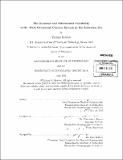The seasonal and interannual variability of the West Greenland current system in the Labrador Sea
Author(s)
Rykova, Tatiana A
DownloadFull printable version (15.02Mb)
Other Contributors
Woods Hole Oceanographic Institution.
Advisor
Fiammetta Straneo.
Terms of use
Metadata
Show full item recordAbstract
The Labrador Sea, as one of a few places of deep water formation, plays an important role in the Meridional Overturning Circulation. While the interior of the Labrador Sea, where the deepest convection takes place, is known to experience variability on time scales ranging from days to decades, little is known about the variability of the other components of the Labrador Sea circulation - the boundary current system and the eddies that connect it with the interior. Using various types of in situ data combined with the surface flux and satellite altimetry data products, I studied the variability of both the boundary current system and the eddies on different time scales as well as their influence on the post-convective re-stratification of the Labrador Sea interior. The analysis presented in the thesis supports the result of the previous theoretical studies that argue that lateral fluxes, driven by the boundary current/interior gradients, play an important role in the post-convective restratification of the Labrador Sea. I found that both components of the boundary current, the surface West Greenland Current and the subsurface Irminger Current, have a strong seasonal cycle. In the spring both the West Greenland and Irminger Currents are colder and fresher than in the fall. However, the West Greenland Current is faster and thicker in the spring while the Irminger Current is the fastest and thickest in the fall. My analysis suggests that the observed seasonal changes in the velocity are primarily due to the baroclinic component of the current while the barotropic component remains nearly unchanged. The Subpolar Gyre, and the Labrador Sea in particular, have experienced a decline in the circulation accompanied by the warming of the water column over the last decades. I found that a similar trend is seen in the West Greenland Current system which slowed down from 1992 to 2004, primarily due to a decrease in the barotropic flow. At the same time, the subsurface Irminger Current has become warmer, saltier, and lighter, something that is also reflected in the properties of the eddies. Two years exhibited pronounced anomalies: in 1997 and 2003 the velocity, temperature and salinity of the Irminger Current abruptly increase with respect to the overall trend. Finally, I discuss the impacts of the boundary current changes on the lateral fluxes that are responsible for the restratification of the Labrador Sea and the properties of the interior.
Description
Thesis (Ph. D.)--Joint Program in Physical Oceanography (Massachusetts Institute of Technology, Dept. of Earth, Atmospheric, and Planetary Sciences; and the Woods Hole Oceanographic Institution), 2010. "June 2010." Cataloged from PDF version of thesis. Includes bibliographical references (p. 151-159).
Date issued
2010Department
Joint Program in Physical Oceanography; Woods Hole Oceanographic Institution; Massachusetts Institute of Technology. Department of Earth, Atmospheric, and Planetary SciencesPublisher
Massachusetts Institute of Technology
Keywords
Joint Program in Physical Oceanography., Earth, Atmospheric, and Planetary Sciences., Woods Hole Oceanographic Institution.